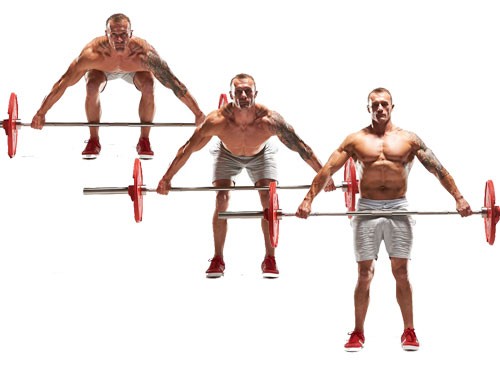4 Reasons to Snatch-Grip Deadlift
There’s a certain kind of walk you end up with after your first few workouts with snatch-grip deadlifts. It tells people from a distance “my entire back from my neck to my knees is sore.”
If that’s not enough proof that they’re great for hitting a lot of muscle at once, here are a few more reasons:
1. Upper-Back and Trap Development
Olympic weightlifters have very impressive back development. Other than pulling from the floor with insane frequency, something they do that most others athletes don’t is make many of those pulls with a wide, or snatch, grip.
If reverse flyes aren’t exploding your rear delts and shrugs aren’t make your upper traps grow as planned, consider adding in snatch-grip deadlifts.
2. Posterior Chain Development
Conventional deadlifts are better known for developing a muscular back than for developing muscular legs because, overall, there’s not a big range of motion in the hips and knees.
With a snatch-grip, even though you’re using less weight, it’s actually more of a leg exercise because your hamstrings and glutes begin in a much deeper position, which is what packs on size.
3. Great Assistance Exercise for Conventional Deadlifts
To improve strength from the floor on a conventional deadlift, many lifters will increase the range of motion by standing on a pile of plates or an aerobic step in order to do “deficit deadlifts.”
While this does work to increase the ROM, it also increases the risk of injury if the plates or step slide while you’re lifting.
The snatch-grip deadlift works as a deficit pull because it forces you to start lower, so you can get all the benefit of deficit work while standing on solid ground.
4. Increased Vertical Jump
A great vertical jump comes from hip extension, which comes from the glutes and posterior chain. The snatch-grip deadlift hammers the glutes and posterior chain.
The starting body position of a great vertical jump very much resembles the starting position of a snatch-grip deadlift. The carryover is there, definitely.
Mastering The Snatch-Grip
Because the wider bar grip stresses the upper back more, it’s that much more important to stay rigid and keep that whole area in tact. Problem is, the upper back is a congregation of many smaller muscles that aren’t nearly as strong as we might like.
When the upper back fails, the shoulders and eventually the lower back will round and cause potentially dangerous failure. Because of this, master a comfortable weight to ease the upper back into the lift.
This is why it’s best to increase volume before weight. If your conventional deadlift is above 350 pounds for reps, it’s best to learn the snatch-grip deadlift using 225 pounds for sets of 5. If you deadlift less, adjust accordingly.
The weight on the bar should only be ramped up after you’ve built the mobility to use maximum grip width and have built the upper back strength to support a good position.
The Stance
Start with the bar close to the shins and lined up over the mid-foot, similar to a standard deadlift. Your feet shouldn’t be as wide as your normal squat stance, but also shouldn’t be as narrow as your normal deadlift stance either.
Your torso needs room at the bottom, so point your feet out 10 to 20 degrees. If you were standing on a clock, that’d be left toes pointing between 11 and 12, right toes pointing between 12 and 1.
This angled foot placement makes getting into the bottom position easier and will encourage your lower back to stay rigid.
The Grip
This is obviously the biggest difference and newest “technique” compared to standard deadlifts, so it deserves the most attention.
A lot of people try snatch-grip deadlifts but bail out after their first set because holding the barbell wider-than-usual has mangled their hands into an awkwardly-cramped claw. But there are solutions.
Most Olympic weightlifters use the hook grip in competition and prefer using straps in training to save their hands from literal wear and tear. The hook grip is when the thumb sandwiched between their other fingers and the bar, instead of being over the fingers.
The hook grip can be as painful as it is useful, so it’s not really meant to be done for long duration (moderate to high rep) sets. It’s much better for just singles or doubles.
So it’s fine to use straps with snatch-grip deadlifts. But skip them on any warm-up sets and save them for the real work sets.
When people think of taking a snatch grip, they automatically picture grabbing the bar from collar to collar, like many (but not all) Olympic lifters do. However, the widest grip I advise is with the index finger just outside the barbell’s last ring.
The narrowest I’d consider for a snatch-grip deadlift would have the pinky around that last ring.

